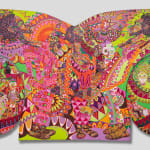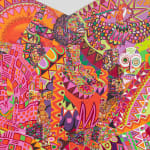 Wadsworth Jarrell, Prophecy
Wadsworth Jarrell, Prophecy
 Wadsworth Jarrell, Prophecy (detail)
Wadsworth Jarrell, Prophecy (detail)
 Wadsworth Jarrell, Prophecy (detail)
Wadsworth Jarrell, Prophecy (detail)
 Wadsworth Jarrell, Prophecy (detail)
Wadsworth Jarrell, Prophecy (detail)
 Installation View, AFRICOBRA: Nation Time, La Biennale di Venezia, 2019
Installation View, AFRICOBRA: Nation Time, La Biennale di Venezia, 2019
Wadsworth Jarrell
Further images
Wadsworth Jarrell (b. 1929, Albany, GA) is a painter, photographer and founding member of AfriCOBRA, a Chicago-based collective of black artists who developed their own visual aesthetic in the art world to empower black communities. Wadsworth’s pattern-intensive portraits, combining vibrant colors and Black Power slogans, depict his drive for political activism. He documented the musical life that flourished in Chicago in the late 1960s-1970s and was a member of the Organization of Black American Culture that painted the “Rhythm and Blues” section of The Wall of Respect mural in the South Side of Chicago. Currently, he continues to experiment in his practice with past and present topics surrounding Blackness.
During his tenure as a professor at Howard University, Jarrell's studies in African art and culture influenced him to incorporate Senufo sculpture symbolism into his art. Robert L. Douglas notes that Jarrell shifted from naturalistic human proportions to the African sculptural style of three to four heads high, typical of the Senufo culture, known for its abstract and geometric forms. Jarrell, a founding member of AfriCOBRA, helped develop a visual aesthetic to empower black communities, marked by vibrant colors, bold text, and positive imagery. His work celebrated black culture and political activism, documenting the vibrant musical scene in Chicago during the late 1960s and 1970s. Jarrell's art is part of numerous prestigious collections and exhibitions, and he continues to explore themes of Blackness in his practice.
Provenance
Collection of Wadsworth JarrellExhibitions
La Biennale di Venezia, AFRICOBRA: Nation Time, Venice, Italy, 2019.Kavi Gupta, Africobra50, Chicago, IL, 2019.
Museum of Contemporary Art North Miami, AFRICOBRA: Messages to the People, 2018.
Atlanta, Georgia, Solo Exhibition, Wadsworth Jarrell, Brawley Library, 1988.
First Black Arts Festival, Lagos, Nigeria, 1998.
Banks-Haley Gallery, Albany, GA, Solo Exhibition, Wadsworth Jarrell, 1979.
FESTAC ‘77, Lagos, Nigeria, 1977.
Literature
J.M. Hayes, AfriCobra; Messages to the People, New York, 2020, illustrated pp, 114 - 115.Robert L Douglas, Wadsworth Jarrell: The Artist as Revolutionary, Pomegranate, 1996, illustrated pp. 46.





